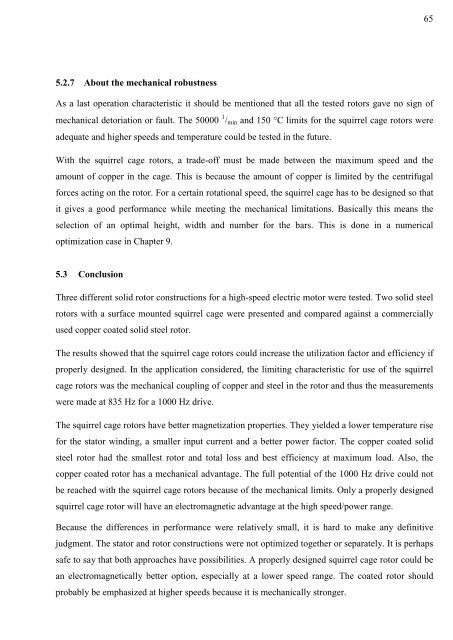Design and Voltage Supply of High-Speed Induction - Aaltodoc
Design and Voltage Supply of High-Speed Induction - Aaltodoc
Design and Voltage Supply of High-Speed Induction - Aaltodoc
You also want an ePaper? Increase the reach of your titles
YUMPU automatically turns print PDFs into web optimized ePapers that Google loves.
5.2.7 About the mechanical robustness<br />
As a last operation characteristic it should be mentioned that all the tested rotors gave no sign <strong>of</strong><br />
mechanical detoriation or fault. The 50000 1 /min <strong>and</strong> 150 °C limits for the squirrel cage rotors were<br />
adequate <strong>and</strong> higher speeds <strong>and</strong> temperature could be tested in the future.<br />
With the squirrel cage rotors, a trade-<strong>of</strong>f must be made between the maximum speed <strong>and</strong> the<br />
amount <strong>of</strong> copper in the cage. This is because the amount <strong>of</strong> copper is limited by the centrifugal<br />
forces acting on the rotor. For a certain rotational speed, the squirrel cage has to be designed so that<br />
it gives a good performance while meeting the mechanical limitations. Basically this means the<br />
selection <strong>of</strong> an optimal height, width <strong>and</strong> number for the bars. This is done in a numerical<br />
optimization case in Chapter 9.<br />
5.3 Conclusion<br />
Three different solid rotor constructions for a high-speed electric motor were tested. Two solid steel<br />
rotors with a surface mounted squirrel cage were presented <strong>and</strong> compared against a commercially<br />
used copper coated solid steel rotor.<br />
The results showed that the squirrel cage rotors could increase the utilization factor <strong>and</strong> efficiency if<br />
properly designed. In the application considered, the limiting characteristic for use <strong>of</strong> the squirrel<br />
cage rotors was the mechanical coupling <strong>of</strong> copper <strong>and</strong> steel in the rotor <strong>and</strong> thus the measurements<br />
were made at 835 Hz for a 1000 Hz drive.<br />
The squirrel cage rotors have better magnetization properties. They yielded a lower temperature rise<br />
for the stator winding, a smaller input current <strong>and</strong> a better power factor. The copper coated solid<br />
steel rotor had the smallest rotor <strong>and</strong> total loss <strong>and</strong> best efficiency at maximum load. Also, the<br />
copper coated rotor has a mechanical advantage. The full potential <strong>of</strong> the 1000 Hz drive could not<br />
be reached with the squirrel cage rotors because <strong>of</strong> the mechanical limits. Only a properly designed<br />
squirrel cage rotor will have an electromagnetic advantage at the high speed/power range.<br />
Because the differences in performance were relatively small, it is hard to make any definitive<br />
judgment. The stator <strong>and</strong> rotor constructions were not optimized together or separately. It is perhaps<br />
safe to say that both approaches have possibilities. A properly designed squirrel cage rotor could be<br />
an electromagnetically better option, especially at a lower speed range. The coated rotor should<br />
probably be emphasized at higher speeds because it is mechanically stronger.<br />
65
















